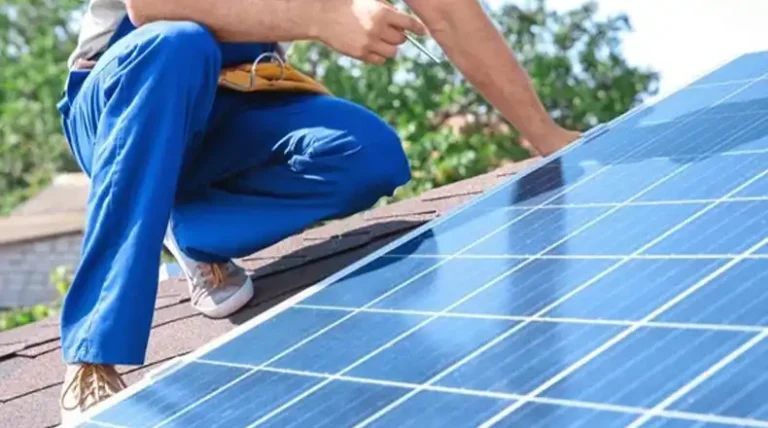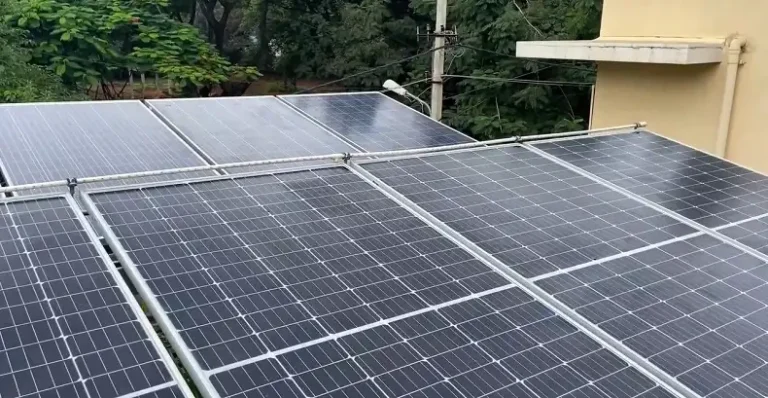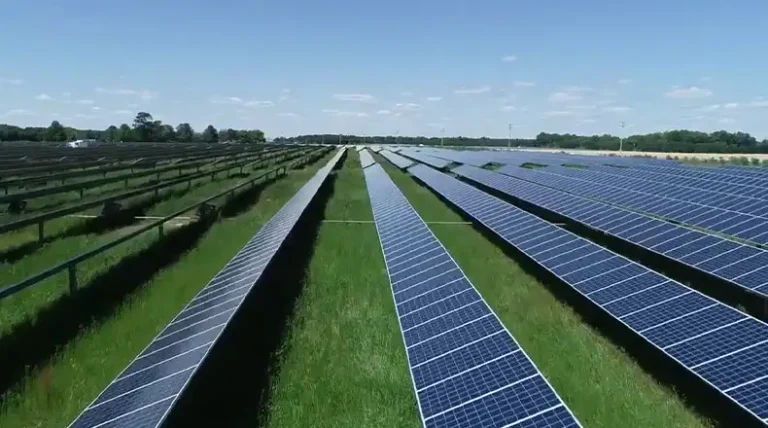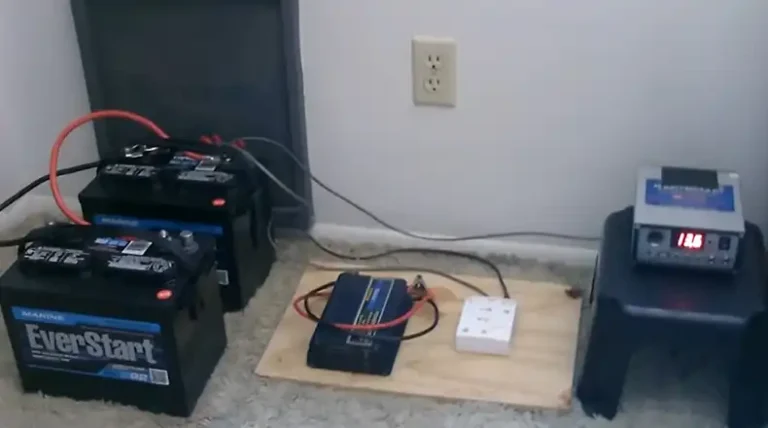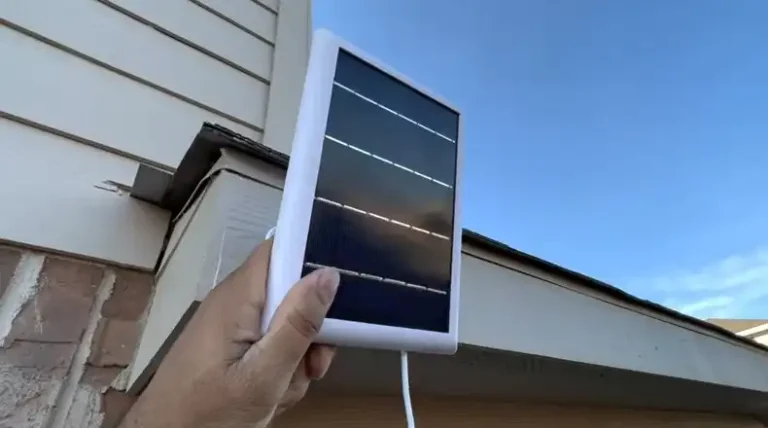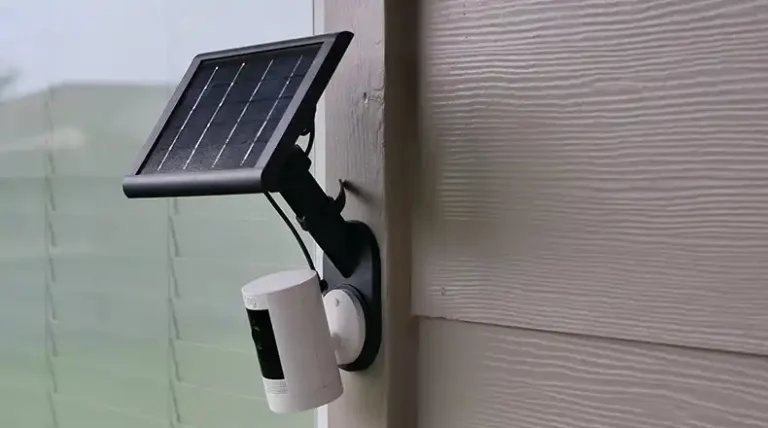How Many Solar Panels Does It Take To Run a 5000 BTU Air Conditioner
Air conditioners are very useful for cooling our homes and offices, but they consume a lot of electricity. An environmentally friendly alternative is powering air conditioners using solar panels. But how many solar panels are needed to run a typical 5000 BTU residential air conditioning unit?
In short, if you are using 250-watt panels, you’d need 2 of them for 5000 BTU AC. But, how to do the exact calculation, and is there anything else to consider? Read on below to find out.
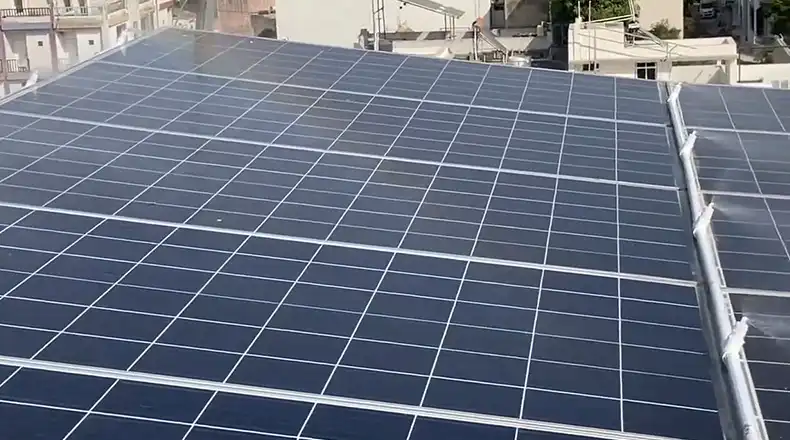
How to Determine Energy Usage of 5000 BTU AC Unit
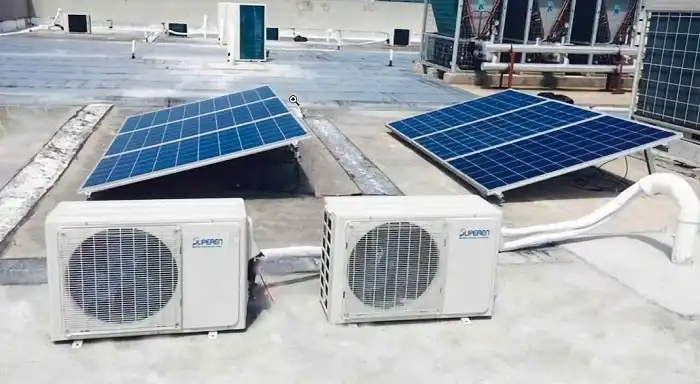
What is a BTU (British Thermal Unit)?
BTU stands for British Thermal Unit and it is a measurement of the amount of energy required to heat or cool one pound of water by one degree Fahrenheit. Air conditioners have a BTU rating that indicates their cooling capacity. A 5000 BTU air conditioner can remove 5000 BTUs of heat energy per hour.
Estimating Power Consumption
In general, a 5000 BTU air conditioner will consume somewhere between 500-1500 watts of electricity when running, depending on the specific efficiency of the unit. More efficient ACs will be on the lower end of this range.
For example, a 5000 BTU window unit with an Energy Efficiency Ratio (EER) of 10 can be estimated to draw around 500 Watts per hour (5000 BTU/hr cooling capacity / 10 EER = 500 Watts/hour). A more efficient 5000 BTU portable AC unit with a 14 EER would draw around 357 Watts per hour (5000 BTU/hr / 14 EER = 357 Watts/hr).
Using Electricity Monitoring Devices
To get an accurate measurement of how much power your specific 5000 BTU AC unit is consuming, you can use an electricity usage monitor like the Kill-A-Watt meter. This allows you to directly measure the unit’s power draw in watts while it is running under normal conditions.
You can then use this wattage data for your solar sizing calculations. Try to monitor the AC’s electricity usage for a full day of operation to account for variability and get a daily kWh consumption figure.
Calculating Based on Efficiency Ratings
If you don’t have an electricity monitor, you can estimate power consumption based on the Energy Efficiency Ratio (EER) or Seasonal Energy Efficiency Ratio (SEER) published by the AC manufacturer. Divide the 5000 BTU capacity by the EER/SEER to get estimated watts used per hour.
For example, a 5000 BTU AC with a SEER of 13 has an estimated draw of 384 Watts per hour of operation (5000 BTU/hr / 13 SEER = 384 Watts/hr).
How Solar Panel Power Production Works?
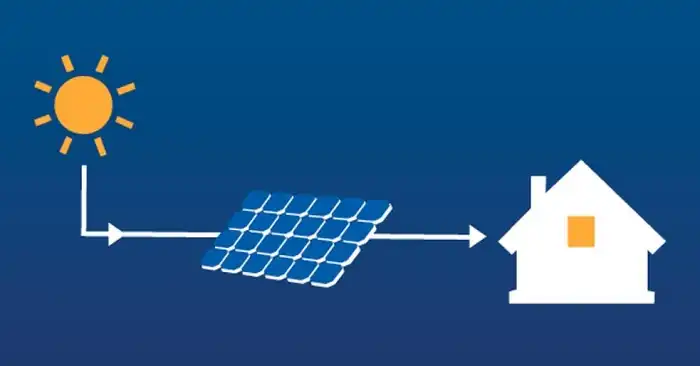
Solar Panel Wattage Ratings
Solar panels have a wattage rating ranging from about 250-400 watts for a standard residential panel. This wattage denotes the panel’s maximum power output under ideal test conditions of 1000 W/m2 solar irradiance.
Real-World Solar Irradiance
In real-world conditions, solar irradiance varies throughout the day and seasons, typically ranging between 200-1000 W/m2. As irradiance decreases from the 1000 W/m2 test standard, solar panel output decreases. Full rated output only occurs during peak sunshine hours when irradiance approaches 1000.
Using Peak Sun Hours Data
Peak Sun Hours represent the average number of hours per day a solar panel can produce its rated wattage. Using local Peak Sun Hours data allows you to estimate actual daily solar production.
For example, if your 300W solar panel is exposed to 5 Peak Sun Hours per day on average, you can expect around 300*5 = 1500 Wh of daily energy production.
Accessing Location-Specific Data
The National Renewable Energy Lab provides Peak Sun Hour data for specific locations through its PVWatts calculator website. Input your address to get monthly and annual average Peak Sun Hours for your area. This provides solar production estimates tailored to your locality.
Solar Array Sizing Calculations for 5000 BTU AC Unit
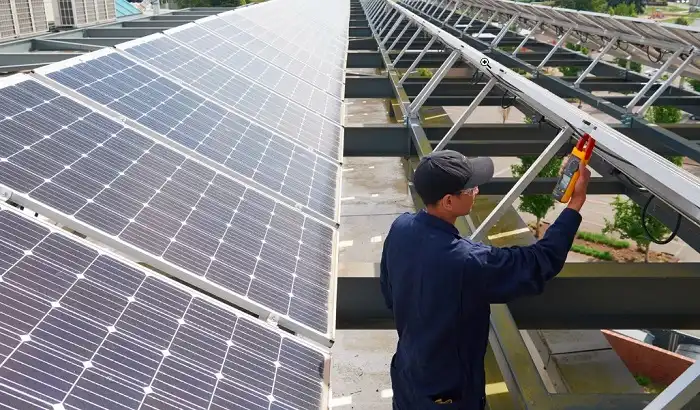
Measuring Daily Energy Consumption
Use an electricity monitor or the AC unit’s specs to determine its average daily energy consumption in watt-hours or kilowatt-hours. Also account for any other loads you want to power like lights, appliances, etc. Obtaining accurate consumption data is crucial.
Factor in Peak Sun Hours
Divide the total daily energy consumption by the Peak Sun Hours for your location. This gives you the minimum solar array wattage needed.
For example, if your measured AC daily consumption is 1500 Wh and you average 5 Peak Sun Hours, 1500Wh/5 hours = 300W minimum solar array size.
Allowing for System Losses
Multiply the minimum solar watts by 1.25 to account for real-world system losses in wires, inverters, charge controllers, battery efficiency, etc. This is the recommended actual solar array wattage.
In our example, 300W * 1.25 = 375W would be the complete solar array size recommendation.
Sizing Example for 5000 BTU AC
Let’s assume based on your electricity monitoring that your 5000 BTU AC unit consumes an average of 1500 Wh per day. You look up your location on the PVWatts calculator and determine your Peak Sun Hours are 5.5 on average.
The wattage calculation would be:
- Daily AC consumption: 1500 Wh/day
- Peak Sun Hours: 5.5
- Minimum solar watts needed: 1500 Wh / 5.5 = 273 Watts
- With the 1.25 derate factor:
- 273 W * 1.25 = 341 Watts
So for this example, you would need a 341 Watt solar panel or panels to power your 5000 BTU AC.
Number of Panels Calculation
If you were going to use 250 Watt solar panels for your system, you can now calculate the number of panels required:
- System watts needed = 341 Watts
- Watts per panel = 250 Watts
- 341 W / 250 W per panel = 1.36 panels
- Rounding up, you would need 2 x 250 Watt panels for this 5000 BTU AC.
Battery Bank Sizing Example
Using the 1500 Wh daily energy consumption for the AC, and 80% depth of discharge for lithium batteries, the battery bank size can be calculated as:
- Daily consumption: 1500 Wh
- Depth of discharge: 80%
- Battery bank capacity: 1500 Wh / 0.8 = 1875 Wh
If using 12V batteries, the capacity in amp-hours is:
- 1875 Wh / 12V = 156 Ah
So you would need around 156 Ah worth of 12V lithium batteries, which could be configured using 2x 12V 100 Ah batteries in parallel.
Other Critical System Components
Batteries – Sizing the Battery Bank
Properly sized batteries are critical for storing solar energy and powering the AC when the sun isn’t shining. Use deep cycle lead acid or lithium batteries and size your battery bank to match your AC’s daily energy usage.
Lithium batteries are recommended for solar air conditioning applications since they are lighter, longer-lasting, more temperature tolerant, and can discharge deeper.
Charge Controller – Selecting and Sizing
The charge controller regulates the power flow between the solar array and the batteries. It prevents overcharging. Choose an MPPT charge controller sized for your total solar wattage and battery voltage. MPPT controllers are more efficient than PWM controllers.
For a 375W solar array and 24V battery bank, a 40A MPPT controller would be appropriately sized. Always match controller voltage to battery voltage.
Inverter – Choosing and Sizing
A pure sine wave inverter is recommended to convert DC solar/battery power to the AC electricity the air conditioner needs. Size your inverter 25-30% larger than the AC unit’s starting surge watts and maximum running watts. This prevents overload.
For a 5000 BTU AC requiring 1500W while running, choose at least a 2000W continuous inverter.
Wires – Guidelines for Wire Gauges
Select copper wires in the appropriate gauge (#10, #8 etc.) to minimize power loss across distances. Follow electrical standards for connecting components. Use thick wires for battery bank connections. Consult wiring tables.
Overcurrent Protection – Fuses and Breakers
Install appropriately sized fuses or circuit breakers to protect against short circuits and equipment damage from current spikes. Choose breaker amp ratings slightly above your system current.
Ways to Optimize the Solar System
Solar Panel Positioning and Orientation
Position solar panels to receive maximum sunlight throughout the day. Face panels south if in the northern hemisphere. Adjust tilt angle seasonally to optimize production. Avoid shading from trees.
Energy Storage Options
Add extra batteries or consider a backup generator to provide power during extended cloudy periods or nighttime AC use. A propane or natural gas standby generator with automatic transfer switch provides backup reliability.
Local Codes, Permits and Incentives
Check local building codes regarding solar installations. Apply for available incentives like federal tax credits and local utility rebates to improve cost-effectiveness. Acquire permits where required prior to constructing your solar system.
Summary of Sizing a Solar System for 5000 BTU AC
The key steps are:
- Determining AC unit power draw
- Calculating solar array size based on location’s Peak Sun Hours
- Selecting properly sized batteries, charge controller, inverter, wires and overcurrent protection.
- Optimizing solar panel placement and angle.
Importance of Load Calculations
Accurately measuring the air conditioner’s energy consumption is crucial for proper solar system sizing. All electrical loads must be accounted for, including appliances running simultaneously with the AC.
Benefits of Solar-Powered AC
Using solar panels to run an air conditioner provides energy cost savings, reduces environmental impact, and can provide backup power during grid outages. With proper sizing, a solar-powered AC system can lower your electricity expenses for many years.
Questions for Your Concern
How many solar panels are needed for a 5000 BTU window AC unit?
For a small 5000 BTU window unit, you would typically need around 300-500 watts of solar panels, assuming 5 Peak Sun Hours of sunshine per day. The exact number depends on the unit’s efficiency and your location’s amount of sunlight.
What size inverter is needed for a 5000 BTU AC?
You’ll want an inverter with a capacity of around 1500-2000 watts to start up and run a 5000 BTU AC unit. Using a pure sine wave inverter instead of a modified sine wave inverter is recommended for smooth operation.
What is the best type of battery for solar AC systems?
Lithium batteries are the best option for solar-powered air conditioning. They are lighter, store more energy, last longer, and have a wider temperature tolerance than lead-acid batteries. Popular choices are lithium iron phosphate and lithium nickel manganese cobalt oxide batteries.
How many batteries would a 5000 BTU AC need?
For 8 hours of cooling per day, you would typically need around 400-500 amp-hours of lithium battery capacity for a 5000 BTU AC unit. The exact amount depends on the AC’s efficiency and desired battery backup time. Using an 80% depth of discharge, a 400 Ah lithium battery bank would work well.
How can I determine my Peak Sun Hours?
Use the National Renewable Energy Lab’s PVWatts calculator online by entering your address. It will estimate the monthly and yearly average Peak Sun Hours for your specific location based on historical weather data. This is crucial for properly sizing your solar array.
What gauge wires should be used in a solar AC system?
For many residential solar system connections, #10 or #8 AWG copper wire will be sufficient. Critical links like the battery interconnections may need thicker #2/0 wire. Follow electrical codes and wire sizing charts to select appropriate gauges for your system based on current, distance and temperature.

